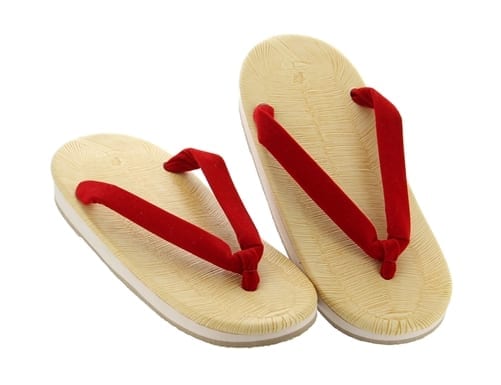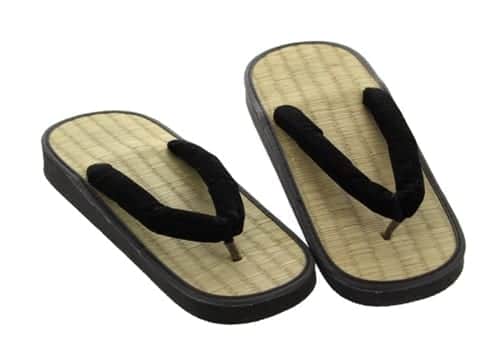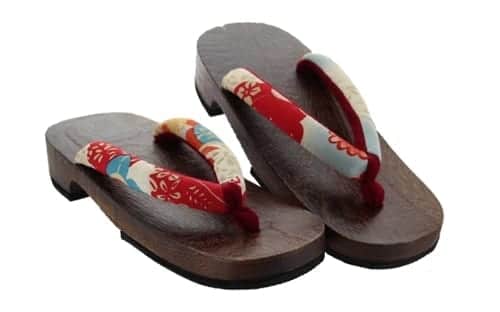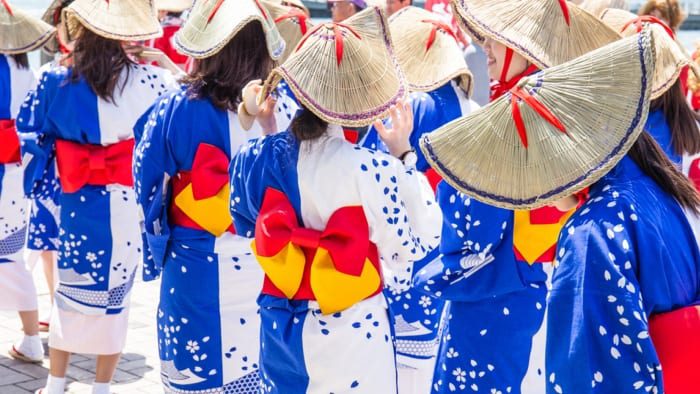Japan has a fascinating history of unique shoes, all sharing a common feature: they resemble flip-flops! While in the West, flip-flops are considered the most casual footwear, in Japan, even the most traditional Japanese shoes feature a thong between the toes, making them suitable for various occasions, including weddings and dinner parties. Amidst a world where shoes evolved to incorporate laces and buckles, why did Japan stick to the thonged sandal? How do these shoes fare in rain, snow, or dirt? The answers may seem unconventional, but they offer intriguing insights.
Similar to how the basic kimono gave rise to several related garments, the basic sandal underwent transformations over time, resulting in various types of traditional Japanese shoes.
Geta: Traditional Japanese Shoes
Geta are versatile traditional Japanese shoes with various sub-designs that make them suitable for almost any weather. Essentially, they are wooden-soled sandals with two “ha” (teeth) supporting them. The wearer places their foot into the thong, with their heel slightly protruding over the sole’s back. Like flip-flops, geta attach to the heel with a soft snap, and their teeth produce a rhythmic percussion as they click on the ground, evoking nostalgia among older Japanese. Held on solely by the sandal thong, they induce a shuffling motion when walking rather than the long stride of a heel-to-toe gait.
Sandals
While geta may not be ideal for running, they served as the most common footwear in Japan for a significant part of its history. Their raised teeth prevent hakama and kimono hemlines from getting dirty in the rain, snow, and dirt-laden streets. Taller geta even elevate workers above debris in their workplaces. Butchers, cooks, and fishermen would toss scraps on the ground, relying on their geta to keep them clean above the mess. Specialized geta have slender teeth that splash less when walking through water, while others have varying heights or feature spikes or metal soles on the teeth’s underside, aiding movement in challenging terrains.
For colder weather, toe-covering geta exist, designed to protect the front of the foot and lined with soft materials like fleece for warmth. Women’s geta can be artistically made to resemble Western high heels or adorned with lacquering and painting, while children’s geta often sport teeth shaped like animal prints or other cute designs. Men’s geta, on the other hand, are typically more square and tend to prioritize practicality over aesthetics. In essence, there is a pair of geta for everyone and every purpose, and they continue to be worn to this day!
Zori
Zori, though simpler than the large wooden geta, were once considered formal shoes. They resemble basic flip-flops, with a thong between the first two toes and flat, low soles. Traditionally, their soles were woven from straw, but modern versions are often made of vinyl or other synthetic materials for a softer feel and more cost-effective production. Some zori are covered with fabric, such as beaded or brocade materials, making them suitable for formal events.
Over time, zori became less formal and more versatile, being easier to wear for many individuals compared to geta. Like rain geta, shigure zori features toe covers to protect against the elements.

Waraji
Waraji are perhaps the simplest traditional shoes. Unlike other types, waraji do not have a thong but instead wrap around the foot and ankle with laces. They are flexible and straightforward, but their durability is limited, and they wear out quickly. Today, waraji are primarily worn by Buddhist monks. In the past, different vocations had distinct ways of tying their waraji; for example, a monk’s tying style differed from that of a farmer or soldier.
A version of waraji sandals worn by many people is called tatami sandals, designed for indoor use only. As outdoor shoes are typically removed at the entrance to a house, these sandals serve as comfortable footwear around the house, akin to slippers.

Fukagutsu
For deep snow, traditional Japanese snow boots, known as fukagutsu, were used. These are no longer produced, as Western snow boots have replaced them. Historically, fukagutsu were made of tightly woven reeds and lined with warm materials for insulation.
Japan’s history of traditional footwear offers a fascinating glimpse into its culture and the evolution of practical and stylish shoes for various occasions and climates.






